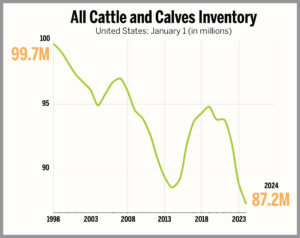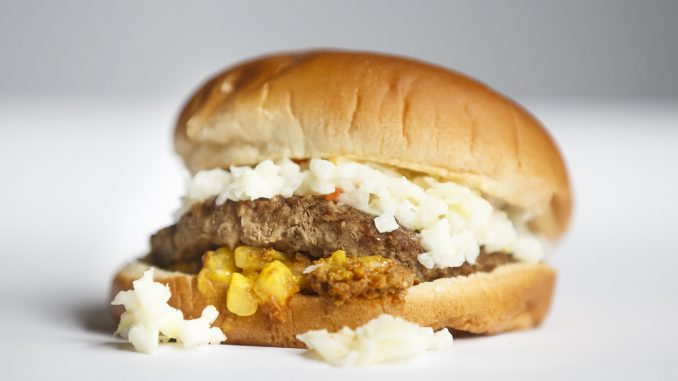RALEIGH — The U.S. cattle supply is at its lowest level since 1951. That low supply will likely drive beef prices to record highs. The supply shortage is being driven by many factors, including droughts, inflation and a burgeoning wave of regulation and activism directed at curbing beef consumption and production. Amidst this backdrop, the future of beef within diets and its role in the agricultural sector is being highlighted by farmers, consumer groups and policymakers.
A December memo released by the United Nations Food and Agriculture Organization (FAO) recommends reducing the amount of beef in diets, increasing non-meat alternatives, and suggests “rebalancing” meat production and consumption. The recommendations from the U.N. are tied to the organization’s climate change agenda.
The FAO memo, advocating for a paradigm shift in livestock management to better align with both nutritional needs and environmental sustainability, outlines a strategy to “Change the livestock population to match not only nutritional needs but also environmental opportunities and constraints.”
According to the FAO, “the livestock sector is composed of a large variety of animals associated with a wide range of GHG (greenhouse gas) footprints and nutritional potential. Under current practices, shifting from large ruminant to small ruminant animals for meat products, and from ruminant to monogastric animals, in particular chicken, will reduce the GHG impacts of animal-food based products.” Ruminant animals, such as cattle, sheep, and goats, have a unique digestive system that allows them to ferment plant-based food in a specialized stomach prior to digestion, a process that produces methane, a greenhouse gas.
U.S. Congressman Mike Flood (R-NE), called the U.N. recommendations “nothing short of a disaster for your health and food security worldwide,” in a December 11, 2023, press release announcing a proposed resolution supporting the U.S. cattle industry. Flood’s resolution expresses the concerns of many within the agricultural community about the potential repercussions of such policies on local economies and food security.
“Meat is one of the most efficient ways to deliver protein, and here in the Beef State, cattle are a critical part of the Golden Triangle that’s supplying clean ethanol fuel around the world,” said Flood. “The resolution I’m introducing today makes it clear that the United States opposes any attempt to reduce or eliminate meat production. Doing so would shatter the world’s food security and end an age-old way of life for millions of farm and ranch families across the globe.”

Despite higher prices, domestic consumer demand for beef remains strong, but is expected to fall in 2024. According to Kansas State University’s Meat Demand Monitor, consumer willingness to pay increased for all retail products other than plant-based patties.
Beef sold for an average of five dollars per pound last year, according to the Bureau of Labor Statistics. Farm Bureau says declining production may lead to record beef prices as consumer demand stays relatively strong but supply withers.
Representative Ashley Hinson (R-IA), a co-sponsor of Flood’s resolution, criticized the underpinnings of the FAO’s motivations, implying a potential conflict of interest shaped by China’s influence.
“It’s laughable that a U.N. agency spearheaded by a top CCP official is calling on Americans to eat less meat in the name of climate change when China is the world’s worst polluter,” said Hinson, referencing Qu Dongyu, Deputy-General of FAO, who is from China. “This is a thinly veiled attempt by China to undermine U.S. agriculture as well as the Iowa farmers who produce high quality meat. The impact of the CCP infiltrating the U.N. is clear: they can strongly call for Americans to stop eating meat, but can’t strongly condemn Hamas for their human rights atrocities in Israel. I’m proud to lead the charge to condemn this nonsense from the U.N. alongside Representative Flood, stand up for U.S. agriculture, and set the record straight.”
In the context of these global discussions and political responses, the internal challenges faced by the U.S. cattle industry, especially concerning cattle supply and replacement inventories, remain pressing. Replacement inventories are essential for introducing new genetics and ensuring the long-term productivity of the herd. Despite a slight projected increase in overall cattle supply in North Carolina, the industry is bracing for significant declines in both beef cow and milk cow replacements, indicative of broader trends affecting the national cattle population.
North Carolina’s top counties for cattle, by head, are Iredell (42,500), Randolph (39,500) and Chatham (31,000). Wilkes, Surry, Cleveland, Sampson, Rowan, Duplin and Union counties are also in the top ten for cattle. Texas, Nebraska, Kansas, California and Oklahoma are the leading cattle-producing states in the U.S.

